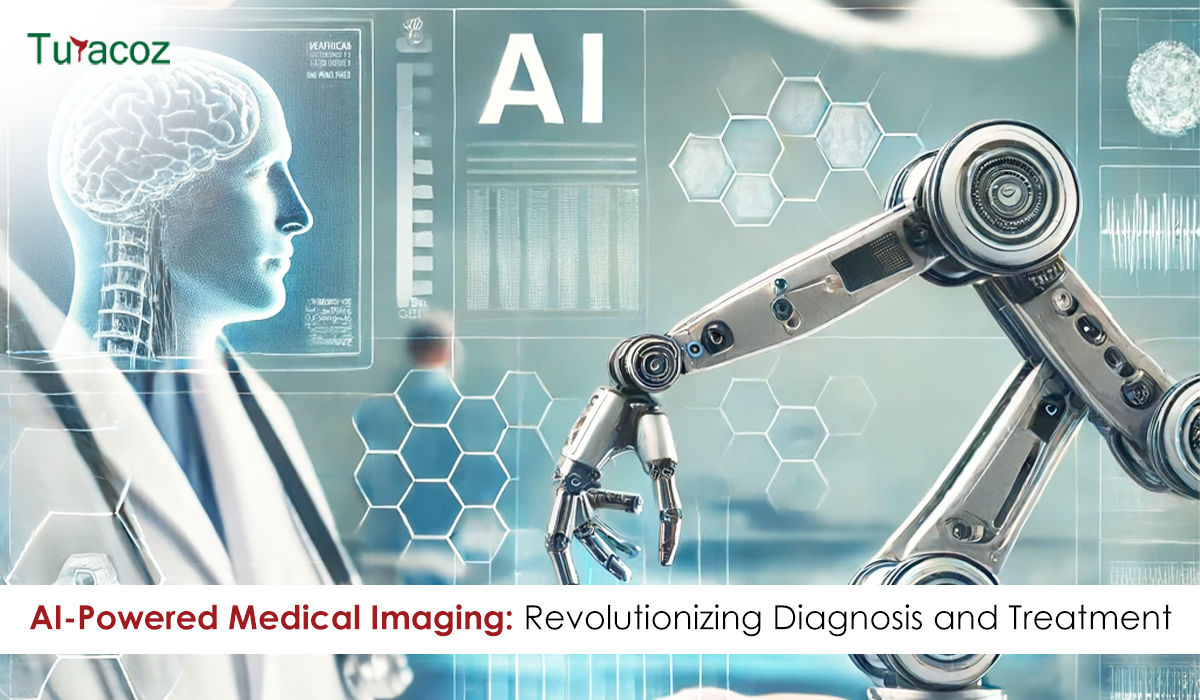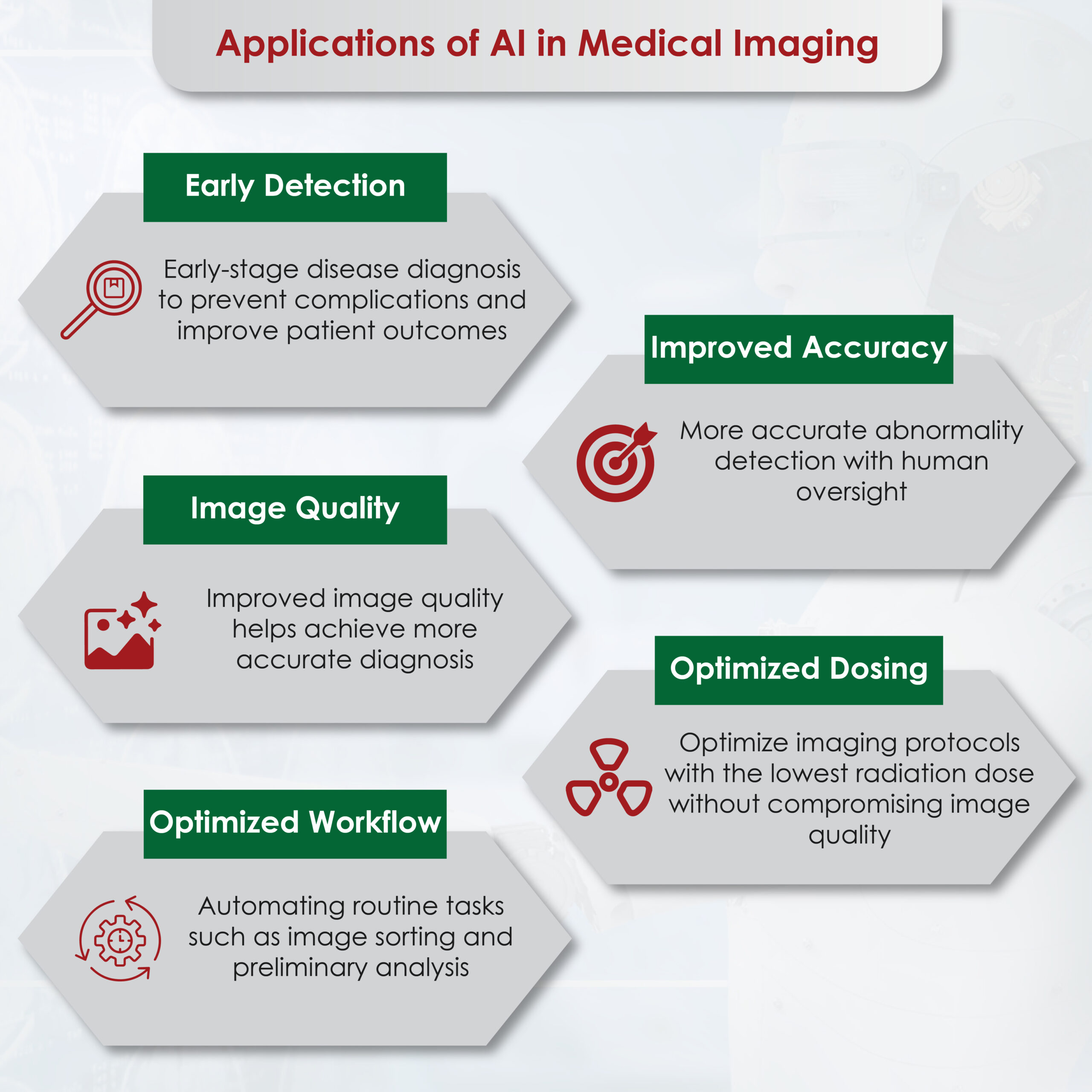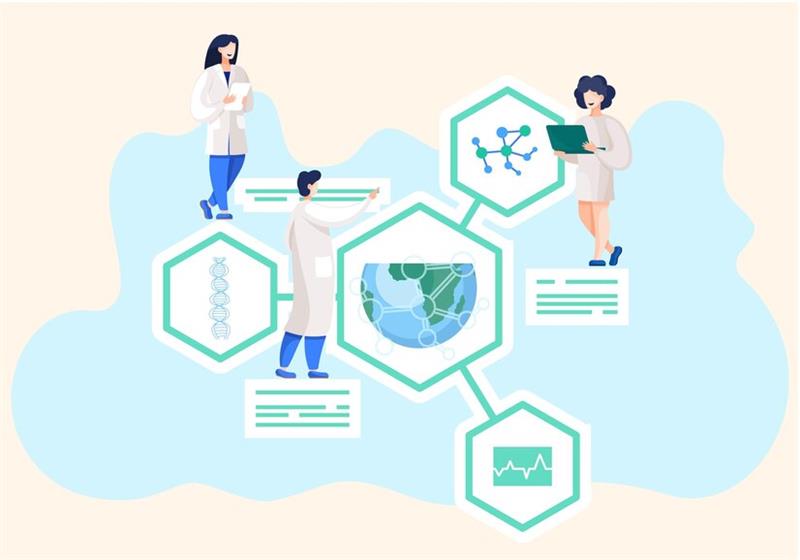Artificial Intelligence (AI) is rapidly transforming the healthcare industry, and medical imaging is at the forefront of this revolution. The integration of AI into medical imaging is enhancing the efficiency, accuracy, and overall quality of diagnostic procedures, thereby improving patient care. AI technologies enable computers to learn from and interpret complex medical data, making it possible to automate and optimize many aspects of medical imaging. This blog explores the current and potential applications of AI in medical imaging, highlighting the advancements, benefits, and challenges associated with this transformative technology.
Current Applications of AI in Medical Imaging
- Image Acquisition and Quality Control
AI has helped enhance the quality and efficiency of image acquisition in medical imaging. AI algorithms can automatically adjust imaging parameters to optimize image quality, reducing the need for repeat scans and minimizing radiation exposure. For example, GE’s Critical Care Suite 2.0 uses AI to assess the quality of chest radiographs in real-time, ensuring that images meet diagnostic standards before they are reviewed by radiologists. Similarly, Philips’ Radiology Smart Assistant provides real-time feedback to radiographers on collimation, rotation, and inspiration during image acquisition, enhancing image quality and departmental productivity by up to 30%.[1]
- Image Interpretation and Diagnosis
AI’s ability to analyze large volumes of data quickly and accurately makes it a valuable tool for image interpretation. AI algorithms can detect anomalies in medical images that might be missed by human eyes, thereby aiding in the early detection of diseases. For instance, AI systems are being used to identify early signs of cancer in mammograms and lung nodules in chest CT scans. These systems can flag suspicious areas for further review, assisting radiologists in making more accurate and timelier diagnoses.
- Workflow Optimization
AI is streamlining workflows in medical imaging departments. By automating routine tasks such as image sorting and preliminary analysis, AI allows radiologists to focus on more complex cases. AI-powered tools can prioritize urgent cases based on the analysis of imaging data, ensuring that critical patients receive prompt attention. This optimization not only improves efficiency but also enhances patient outcomes by reducing the time to diagnosis and treatment.
- Radiation Dose Reduction
One of the significant concerns in medical imaging is the exposure of patients to radiation. AI is helping mitigate this risk by optimizing imaging protocols to use the lowest possible radiation dose without compromising image quality. Deep learning-based reconstruction algorithms, like GE’s TrueFidelity, produce high-quality images from low-dose CT scans, significantly reducing the radiation exposure to patients.
Potential Applications of AI in Medical Imaging
AI’s potential in medical imaging extends far beyond current applications:
- Personalized Imaging Protocols
AI has the potential to personalize imaging protocols based on individual patient characteristics. By analyzing a patient’s medical history, demographics, and previous imaging studies, AI can tailor imaging protocols to ensure optimal results. This personalized approach can improve diagnostic accuracy and reduce unnecessary imaging.
- Advanced Image Reconstruction
Future advancements in AI could lead to more sophisticated image reconstruction techniques. AI could enhance the resolution and clarity of images obtained from low-quality scans, making it easier to identify and diagnose conditions. For instance, AI algorithms could reconstruct images from non-contrast scans to mimic the quality of contrast-enhanced scans, potentially eliminating the need for contrast agents and reducing the risk of adverse reactions.
- Predictive Analytics
AI can leverage predictive analytics to foresee equipment failures and maintenance needs, minimizing downtime in imaging departments. Predictive models can analyze data from imaging equipment to predict when maintenance is required, ensuring that machines are always operational and reducing disruptions in patient care.
- Integration with Other Data Sources
The integration of AI with electronic health records (EHRs) and other data sources can provide a more comprehensive view of a patient’s health. AI can correlate imaging findings with clinical data, lab results, and genetic information to offer a more accurate and holistic diagnosis. This integration can also aid in monitoring disease progression and treatment response, allowing for more precise and effective interventions.
Challenges and Considerations
- Ethical and Legal Issues
The implementation of AI in medical imaging raises several ethical and legal issues. Ensuring patient privacy and data security is paramount, especially given the sensitivity of medical information. Moreover, the use of AI algorithms that are not fully transparent can lead to trust issues among healthcare professionals and patients. It is essential to develop ethical guidelines and regulatory frameworks to address these concerns.
- Training and Education
Healthcare professionals need to be adequately trained to use AI tools effectively. This includes understanding how AI algorithms work, their limitations, and how to interpret their results. Continuous education and training programs are necessary to keep up with the rapid advancements in AI technology.
- Integration with Existing Systems
Integrating AI into existing medical imaging systems can be challenging. Compatibility issues, data standardization, and the need for robust IT infrastructure are some of the hurdles that need to be addressed. Collaboration between technology providers and healthcare institutions is crucial to ensure seamless integration and adoption of AI solutions.
- Bias and Accuracy
AI algorithms are only as good as the data they are trained on. Bias in training data can lead to inaccurate or unfair outcomes, particularly for underrepresented groups. It is essential to use diverse and representative datasets to train AI models and continuously monitor their performance to ensure accuracy and fairness.
Conclusion
The current and potential applications of AI in medical imaging are vast and transformative. AI is already enhancing image acquisition, interpretation, workflow optimization, and radiation dose reduction. Future advancements promise even more personalized, accurate, and efficient imaging practices. However, addressing the ethical, legal, and practical challenges associated with AI implementation is crucial to fully realizing its potential. As AI continues to evolve, it will undoubtedly play a pivotal role in shaping the future of medical imaging and improving patient care.
AI’s integration into medical imaging is not just a technological advancement but a step towards more personalized and effective patient care. By embracing these advancements and addressing the associated challenges, the healthcare industry can harness the full potential of AI to revolutionize medical imaging practices and outcomes.
References:
- Potočnik J, Foley S, Thomas E. Current and potential applications of artificial intelligence in medical imaging practice: A narrative review. J Med Imaging Radiat Sci. 2023;54(2):376-385. doi:10.1016/j.jmir.2023.03.033







































